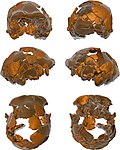Paleopathology, also spelled palaeopathology, is the study of ancient diseases and injuries in organisms through the examination of fossils, mummified...
31 KB (3,824 words) - 15:48, 6 September 2024
Egg paleopathology is the study of evidence for illness, injury, and deformity in fossilized eggs. A variety of pathological conditions afflicting eggs...
10 KB (1,338 words) - 21:24, 7 March 2024
Smilodon (section Paleopathology)
Smilodon is an extinct genus of felids. It is one of the best known saber-toothed predators and prehistoric mammals. Although commonly known as the saber-toothed...
109 KB (12,217 words) - 22:04, 22 November 2024
Plesiosaur (section Paleopathology)
The Plesiosauria or plesiosaurs are an order or clade of extinct Mesozoic marine reptiles, belonging to the Sauropterygia. Plesiosaurs first appeared in...
137 KB (13,418 words) - 03:13, 5 November 2024
Saurolophus (section Paleopathology)
Saurolophus (/sɔːˈrɒləfəs/; meaning "lizard crest") is a genus of large hadrosaurid dinosaur from the Late Cretaceous period of Asia and North America...
34 KB (3,469 words) - 17:47, 20 November 2024
Dromaeosauridae (section Paleopathology)
Dromaeosauridae (/ˌdrɒmi.əˈsɔːrɪdiː/) is a family of feathered coelurosaurian theropod dinosaurs. They were generally small to medium-sized feathered carnivores...
92 KB (9,247 words) - 22:23, 20 November 2024
Ceprano Man (section Paleopathology)
Ceprano Man, Argil, and Ceprano Calvarium, is a Middle Pleistocene archaic human fossil, a single skull cap (calvarium), accidentally unearthed in a highway...
26 KB (2,891 words) - 05:03, 2 November 2024
Centrosaurus (section Paleopathology)
Centrosaurus (/ˌsɛntroʊˈsɔːrəs/ SEN-troh-SOR-əs; lit. 'pointed lizard') is a genus of centrosaurine ceratopsian dinosaur from Campanian age of Late Cretaceous...
22 KB (2,027 words) - 18:51, 25 June 2024
Eubrontes (section Paleopathology)
dinosauromorfos. Spain: Larousse. pp. 95 & 120. Molnar, R. E., 2001, Theropod paleopathology: a literature survey: In: Mesozoic Vertebrate Life, edited by Tanke...
10 KB (1,029 words) - 22:47, 30 July 2024
Dilophosaurus (section Paleopathology)
77 lb) per year early in life. The holotype specimen had multiple paleopathologies, including healed injuries and signs of a developmental anomaly. Dilophosaurus...
119 KB (14,566 words) - 06:11, 2 November 2024
Sinraptor (section Paleopathology)
1093/zoolinnean/zlae090. ISSN 0024-4082. Molnar, R. E., 2001, Theropod paleopathology: a literature survey: In: Mesozoic Vertebrate Life, edited by Tanke...
8 KB (706 words) - 12:08, 22 September 2024
Paleoecology Paleogenetics Paleolimnology Paleomycology Paleoneurobiology Paleopathology Paleopedology Paleotempestology Paleozoology Palynology Sclerochronology...
102 KB (10,183 words) - 12:35, 2 November 2024
Camarasaurus (section Paleopathology)
Camarasaurus (/ˌkæmərəˈsɔːrəs/ KAM-ər-ə-SOR-əs) was a genus of quadrupedal, herbivorous dinosaurs and is the most common North American sauropod fossil...
63 KB (7,119 words) - 17:28, 14 September 2024
Theropoda (section Paleopathology)
and punctures, often likely originating with bites. Some theropod paleopathologies seem to be evidence of infections, which tended to be confined only...
71 KB (7,622 words) - 20:15, 16 November 2024
Telmatosaurus (section Paleopathology)
Telmatosaurus (meaning "marsh lizard") is a genus of basal hadrosauromorph dinosaur from the Late Cretaceous of Romania. It was a relatively small hadrosaur...
7 KB (789 words) - 16:25, 3 October 2024
Diplodocidae (section Paleopathology)
Diplodocids, or members of the family Diplodocidae ("double beams"), are a group of sauropod dinosaurs. The family includes some of the longest creatures...
37 KB (3,718 words) - 12:41, 20 November 2024
Citipati (section Paleopathology)
Citipati ([ˈtʃiːt̪ɪpət̪i]; meaning "funeral pyre lord") is a genus of oviraptorid dinosaur that lived in Asia during the Late Cretaceous period, about...
39 KB (4,281 words) - 07:11, 2 November 2024
Machairodontinae (section Paleopathology)
on the care of its parents.[citation needed] In another example of paleopathology supporting the social hypothesis, a large number of Smilodon fossils...
80 KB (8,386 words) - 20:03, 18 November 2024
Tylosaurus (section Paleopathology)
Tylosaurus (/ˌtaɪˈloʊˈsɔːrəs/; "knob lizard") is a genus of russellosaurine mosasaur (an extinct group of predatory marine lizards) that lived about 92...
96 KB (10,200 words) - 23:23, 11 November 2024
Allosaurus (section Paleopathology)
scavengers of giant sauropod-falls, Interestingly, a recent review of paleopathologies in theropods may support this conclusion. The researchers found a positive...
132 KB (14,969 words) - 22:27, 20 November 2024
Iguanodon (section Paleopathology)
Iguanodon (/ɪˈɡwɑːnədɒn/ i-GWAH-nə-don; meaning 'iguana-tooth'), named in 1825, is a genus of iguanodontian dinosaur. While many species found worldwide...
96 KB (10,953 words) - 08:52, 2 November 2024
Mosasaurus (section Behavior and paleopathology)
Mosasaurus (/ˌmoʊzəˈsɔːrəs/; "lizard of the Meuse River") is the type genus (defining example) of the mosasaurs, an extinct group of aquatic squamate reptiles...
156 KB (16,413 words) - 14:52, 21 November 2024
Kocabaş cranium (section Paleopathology)
The Kocabaş cranium is the damaged calvarium fossil of a young Homo erectus discovered near the village of Kocabaş, located in the Denizli Province of...
13 KB (1,508 words) - 23:29, 4 September 2024
Cryolophosaurus (section Paleopathology)
Cryolophosaurus (/ˌkraɪəˌloʊfəˈsɔːrəs/ or /kraɪˌɒləfəˈsɔːrəs/; KRY-ə-LOH-fə-SAWR-əs) is a genus of large theropod dinosaur known from only a single species...
36 KB (3,483 words) - 15:18, 2 November 2024
diseases is pinta, a skin disease and therefore unrecoverable through paleopathology.) Ancient DNA (aDNA) holds the answer, because just as only aDNA suffices...
99 KB (10,412 words) - 22:50, 3 November 2024
Theropod paleopathology is the study of injury and disease in theropod dinosaurs. In 2001, Ralph E. Molnar published a survey of pathologies in theropod...
45 KB (4,799 words) - 14:07, 21 April 2024
them. (Pinta is a skin disease and therefore unrecoverable through paleopathology.) Ancient DNA (aDNA) holds the answer, because just as only aDNA suffices...
72 KB (8,981 words) - 13:34, 5 November 2024
there in 1999. She spent seven years working part-time on her PhD in paleopathology, receiving the degree in 2008. She was a senior teaching fellow at the...
45 KB (3,950 words) - 21:16, 9 November 2024
Velociraptor (section Paleopathology)
Knopf Inc. p. 43. ISBN 9780520225015. Molnar, R.E. (2001). "Theropod Paleopathology: A Literature Survey". In Carpenter, Kenneth; Skrepnick, Michael William;...
73 KB (8,013 words) - 02:58, 13 November 2024
Protoceratops (section Paleopathology)
Protoceratops (/ˌproʊtoʊˈsɛrətɒps/; lit. 'first horned face') is a genus of small protoceratopsid dinosaurs that lived in Asia during the Late Cretaceous...
157 KB (18,767 words) - 14:51, 8 November 2024




























